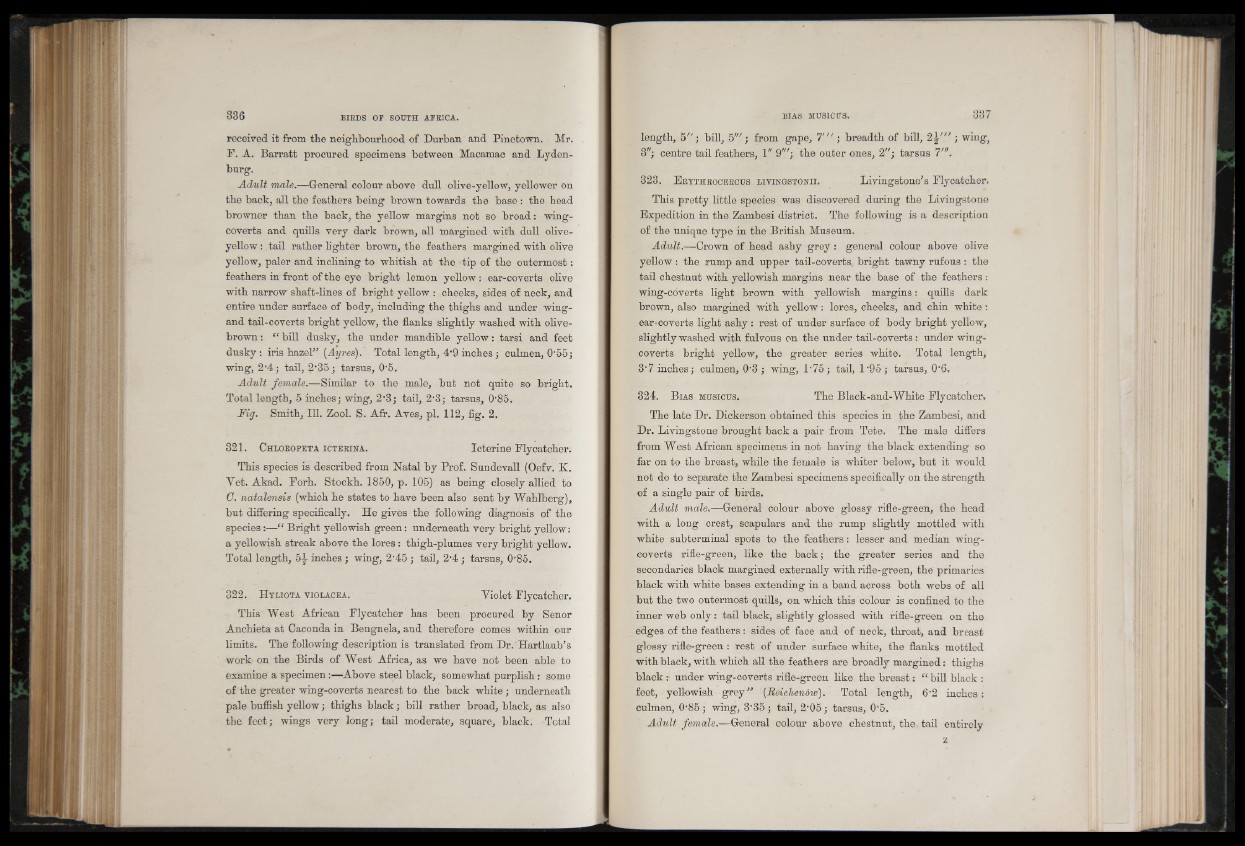
received it from the neighbourhood of Durban and Pinetown. Mr.
F. A. Barratt procured specimens between Macamac and Lyden-
burg.
Adult male.—General colour above dull olive-yellow, yellower on
the back, all the feathers being brown towards the base : the head
browner than the back, the yellow margins not so broad: wing-
coverts and quills very dark brown, all margined with dull olive-
yellow :. tail rather lighter brown, the feathers margined with olive
yellow, paler and inclining to whitish at the tip of the outermost:
feathers in front of the eye bright lemon yellow: ear-coverts olive
with narrow shaft-lines of bright yellow : cheeks, sides of neck, and
entire under surface of body, including the thighs and under wing-
and tail-coverts bright yellow, the flanks slightly washed with olive-
brown : “ bill dusky, the under mandible yellow: tarsi and feet
dusky : iris hazel” {Ayres). Total length, 4'9 inches; culmen, 0‘55;
wing, 2-4 ; tail, 2'35; tarsus, 0'5.
Adult female.—Similar to the male, but not quite so bright.
Total length, 5 inches; wing, 2’3; tail, 2'3; tarsus, 0'85.
Fig. Smith, 111. Zool. S. Air. Aves, pi. 112, fig. 2.
321. C h lo r o p e t a ic t e renta. Icterine Flycatcher.
This species is described from Natal by Prof. Sundevall (Oefv. K.
Vet. Akad. Forh. Stockh. 1850, p. 105) as being closely allied to
C. natalensis (which he states to have been also sent by Wahlberg),
but differing specifically. He gives the following diagnosis of the
species:—“ Bright yellowish green: underneath very bright yellow:
a yellowish streak above the lores: thigh-plumes very bright yellow.
Total length, 5|- inches; wing, 2-45 ; tail, 2-4 ; tarsus, 0'85.
322. H yliota violacea. Violet Flycatcher.
This West African Flycatcher has been procured by Senor
Anchieta at Caconda in Bengnela, and therefore comes within our
limits. The following description is translated from Dr. Hartlaub’s
work on the Birds of West Africa, as we have not been able to
examine a specimen:—Above steel black, somewhat purplish: some
of the greater wing-coverts nearest to the back white; underneath
pale huffish yellow; thighs black; bill rather broad, black, as also
the feet; wings very long; tail moderate, square, black. Total
length, W ; bill, 5'" ; from gape, T " ; breadth of bill, 2^/ / ; ; wing,
3"; centre tail feathers, V 9W/; the outer ones, 2"; tarsus 7"'.
323. E rythrocercus liv tn g ston ii. Livingstone’s Flycatcher.
This pretty little species was discovered during the Livingstone
Expedition in the Zambesi district. The following is a description
of the unique type in the British Museum.
Adult.—Crown of head ashy grey: general colour above olive
yellow : the rump and upper tail-coverts, bright tawny rufous : the
tail chestnut with yellowish margins near the base of the feathers:
wing-coverts light brown with yellowish margins: quills dark
brown, also margined with yellow: lores, cheeks, and chin white:
ear-coverts light ashy: rest of under surface of body bright yellow,
slightly washed with fulvous on the under tail-coverts: under wing-
coverts bright yellow, the greater series white. Total length,
3'7 inches; culmen, 0‘3 ; wing, 1‘75; tail, 1 '95 ; tarsus, 0‘6.
324. B ias musicus. The Black-and-White Flycatcher.
The late Dr. Dickerson obtained this species in the Zambesi, and
Dr. Livingstone brought back a pair from Tete. The male differs
from West African specimens in not having the black extending so
far on to the breast, while the female is whiter below, but it would
not do to separate the Zambesi specimens specifically on the strength
of a single pair of birds.
Adult male.—General colour above glossy rifle-green, the head
with a long crest, scapulars and the rump slightly mottled with
white subterminal spots to the feathers: lesser and median wing-
coverts rifle-green, like the back; the greater series and the
secondaries black margined externally with rifle-green, the primaries
black with white bases extending in a band across both webs of all
but the two outermost quills, on which this colour is confined to the
inner web only: tail black, slightly glossed with rifle-green on the
edges of the feathers: sides of face and of neck, throat, and breast
glossy rifle-green : rest of under surface white, the flanks mottled
with black, with which all the feathers are broadly margined: thighs
black : under wing-coverts rifle-green like the breast: “ bill black :
feet, yellowish grey” {Reichenow). Total length, 6'2 inches:
culmen, 0-85; wing, 3'35; tail, 2-05; tarsus, 0-5.
Adult female.—General colour above chestnut, the. tail entirely